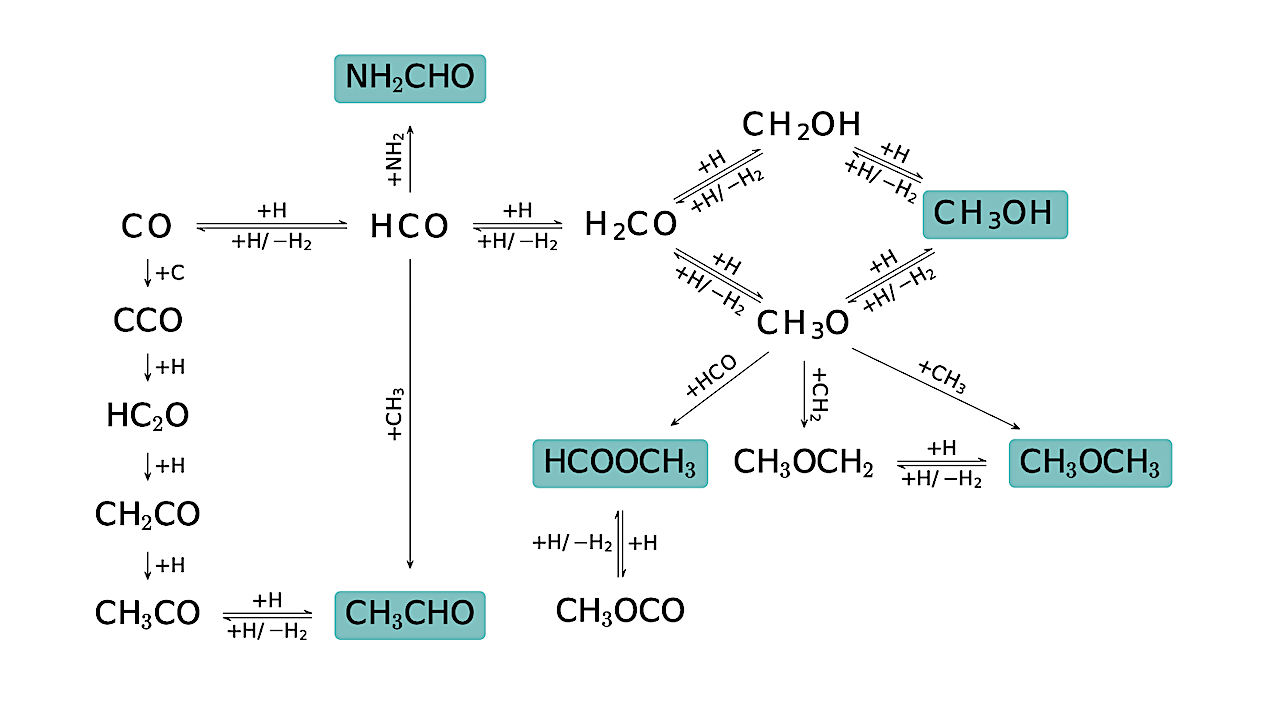The major COMs formation routes on grain surface. The COMs studied in our simulations have teal background. The species involved in the methanol formation chain are highlighted in bold. The chemical desorption in the COMs surface formation reactions is the main source of the gaseous COMs. The expressions +H and +H/−H2 together denote a pair of reactions, H-atom addition and H-atom abstraction. — astro-ph.GA
We present the results of astrochemical modeling of complex organic molecules (COMs) in the ice and gas of the prestellar core L1544 with the recently updated MONACO rate equations-based model.
The model includes, in particular, non-diffusive processes, new laboratory verified chemical routes for acetaldehyde and methane ice formation and variation of H and H2 desorption energies depending on the surface coverage by H2 molecules.
For the first time, we simultaneously reproduce the abundances of several oxygen-bearing COMs in the gas phase, the approximate location of the peak of methanol emission, as well as the abundance of methanol in the icy mantles of L1544.
Radical-radical reactions on grains surface between species such as CH3, CH3O and HCO efficiently proceed non-diffusively. COMs are delivered to the gas phase via chemical desorption amplified by the loops of H-addition/abstraction surface reactions.
However, gas-phase chemical reactions as well provide a noticeable input to the formation of COMs in the gas, but not to the COMs solid-state abundances. This particularly applies for CH3CHO and CH3OCH3. The simulated abundances of COMs in the ice are in the range 1%–2% (for methyl formate ice) or ∼~0.1% (for CH3CHO and CH3OCH3) with respect to the abundance of H2O ice.
We stress a similarity between the simulated abundances of icy COMs in L1544 and the abundances of COMs in the gas phase of hot cores/corinos. We compare our non-diffusive model with the diffusive model and provide constraints for the species’ diffusion-to-desorption energy ratios.
Katerina Borshcheva (1 and 2), Gleb Fedoseev (3, 4 and 1), Anna F. Punanova (5), Paola Caselli (6), Izaskun Jiménez-Serra (7), Anton I. Vasyunin (1) ((1) Research Laboratory for Astrochemistry, Ural Federal University, Yekaterinburg, Russia (2) Institute of Astronomy of the Russian Academy of Sciences, Moscow, Russia (3) Xinjiang Astronomical Observatory, Chinese Academy of Sciences, Urumqi, China (4) Xinjiang Key Laboratory of Radio Astrophysics, Urumqi, China (5) Onsala Space Observatory, Råö, Onsala, Sweden (6) Max-Planck-Institute for Extraterrestrial Physics, Garching, Germany (7) Centro de Astrobiologia (CSIC-INTA), Torrejon de Ardoz Madrid, Spain)
Comments: 34 pages, 13 figures, 10 tables, accepted to The Astrophysical Journal
Subjects: Astrophysics of Galaxies (astro-ph.GA)
Cite as: arXiv:2507.00338 [astro-ph.GA] (or arXiv:2507.00338v1 [astro-ph.GA] for this version)
https://doi.org/10.48550/arXiv.2507.00338
Focus to learn more
Submission history
From: Anton Vasyunin
[v1] Tue, 1 Jul 2025 00:35:09 UTC (629 KB)
https://arxiv.org/abs/2507.00338
Astrobiology
